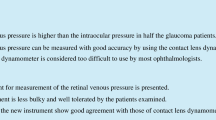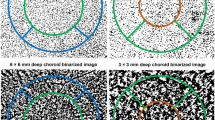Abstract
In the evaluation of stereochronoscopic pairs of fundus pictures (Sc) venous pulse is an interfering factor. Visual observation and photography show that when a magnification of 15 × is used, as in our case, venous pulse is seen only at the emerging part of the big veins and in their immediate neighborhood, whereas veins of 100 μm diameter or less show no pulsation. Over relatively short time intervals (some minutes) the temporal course of venous pulse in terms of vessel width is a more or less periodic phenomenon; for longer periods (months) a study is underway. In the majority of cases the filling state of pulsating veins seems to reach a minimum shortly after the R peak of the ECG. An investigation as to whether the interference of venous pulse can be reduced by coupling the camera flash to the R peak has been begun. However, for the time being, it appears that the best method is to pass over the pulsating vessel parts, and to observe Sc effects only in the small vessels, when Sc evaluation is applied. Statistics show that venous pulse is significantly more frequent in suspected and early glaucoma subjects (T>21 mm appl.) than in healthy subjects. We feel that with the methods proposed all conditions pertaining to an extensive follow-up of ocular hypertension and early glaucoma cases are now established.
Zusammenfassung
Bei der Auswertung stereochronoskopischer Bildpaare des Fundus (Sc) tritt der Venenpuls als Störfaktor auf. Visuelle Beobachtung und Photographie zeigen, daß Venenpuls mit der von uns benutzten Vegrößerung von 15 × nur am oder nahe dem Austrittsgebiet der großen Venen der Papille festzustellen ist, während bei Gefäßen von 100 μm Durchmesser und weniger keine Pulsation zu sehen ist. Über kurze Zeiten (einige Minuten) ist der Verlauf des Venenpulses, gemessen als Gefäßdurchmesser, ein mehr oder weniger periodischer Vorgang; für größere Zeitabstände (Monate) wird die Frage untersucht. Der Füllungszustand der betreffenden Venen scheint in der Mehrzahl der Fälle kurz nach der R-Zacke des EKG ein Minimum zu erreichen. Wir untersuchen z.Z., ob sich der störende Einfluß des Venenpulses durch Kopplung des Kamera-Blitzes an die R-Zacke vermindern läßt. Vorderhand scheint es am sichersten, die fraglichen Gefäßteile bei der Sc-Auswertung außer acht zu lassen, und die Sc-Phänomene an den kleinen Gefäßen zu untersuchen. Eine Statistik an Fällen von vermutetem oder sicherem beginnenden Glaukom mit Augendrucken über 21 mm appl. zeigt, daß Venenpuls hier mit einer statistisch gesicherten größeren Häufigkeit auftritt. Wir sind der Ansicht, daß mit der vorgeschlagenen Methodik nun alle Bedingungen gegeben sind, um große serien von Fällen mit ocular hypertension und beginnendem Glaukom zu untersuchen.
Similar content being viewed by others
References
Bracher, D., Dozzi, M., Lotmar, W.: Measurement of vessel width on fundus photographs. Albrecht v. Graefes Arch. Klin. Ophthalmol.211, 35–48 (1979)
Bynke, H.G., Krakau, C.E.T.: Rapid variations of the prominent optic disc. II. Demonstration of pulse-synchronous waves. Acta Ophthal.39, 501–506 (1961)
Goldmann, H., Lotmar, W.: Rapid detection of changes in the optic disc: Stereochronoscopy. Albrecht v. Graefes Arch. Klin. Ophthalmol.202, 87–99 (1977)
Goldmann, H., Lotmar, W.: Rapid detection of changes in the optic disc: Stereochronoscopy. II. Evaluation technique, influence of some physiologic factors, and follow up of a case of choked disc. Albrecht v. Graefes Arch. Klin. Ophthalmol.205, 263–277 (1978)
Kommerell, G.: Schlängelung der Netzhautarterien durch die Pulswelle (Meandering of retinal arteries from pulse wave: a stereochronoscopic study). Klin. Monatsbl. Augenheilkd.173, 486–488 (1978)
Lotmar, W., Goldmann, H., Brückner, R.: Zur Bestimmung zeitlicher Veränderungen der Papille bei normalen Erwachsenen. Klin. Monatsbl. Augenheilkd.173, 480–486 (1978)
Spahr, J., Fankhauser, F., Jenni, A., Bebie, H.: Praktische Erfahrungen mit dem automatischen Perimeter Octopus. Klin. Monatsbl. Augenheilkd.172, 470–477 (1978)
Author information
Authors and Affiliations
Rights and permissions
About this article
Cite this article
Goldmann, H., Lotmar, W. Rapid detection of changes in the optic disc: Stereochronoscopy. Albrecht v Graefes Arch. klin. exp. Ophthal. 211, 243–249 (1979). https://doi.org/10.1007/BF02387430
Received:
Issue Date:
DOI: https://doi.org/10.1007/BF02387430




